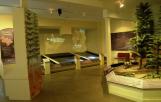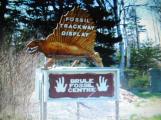1
The Brule Fossils. Tracks found on the Brule shorePermian -over 290 million years ago
Brule, Nova Scotia, Canada
 Credits:
Credits:Skyline Atlantic Canada
2
In 1994 the Van Allen brothers were splashing along the Brule shore, 6 km east of Tatamagouche; the tide was swirling the sand across the local sandstone rocks, when they happened to notice what appeared to be small footprnts tracking across the rock face. This led to an amazing geological 'find'; the footprints were from the Permian period, and were 290 million years old, pre-dating the dinosaurs by about 50 million years. The find was considered by a fossil footprint expert to be one of the most important Palaeozic sites in Eastern North America and the WorldAt the press of various buttons,different coloured footprint traces appear on the wall clarifying the actual prints seen on the rock face on the ground in front of the visitor. .
4
Identified as Seymouria- a small amphibian/reptile - 2 feet (60 cms) long - living both in and out of water, these creatures appeared to live in groups - the first evidence of herding behaviour.Other foorprints indicated that the larger, sharp clawed and vicious toothed Dimetrodon - up to 15 feet (457 cms )long - preyed on the smaller seymouria amidst the swampy environment of the Walchia forest. A primitive form of conifer,these fossil trees were the largest stand ever found in their growth position - here they were with the animal tracks running along the forest floor. There was evidence too of giant dragonflies with a wing span of about 60 cms flitting through the trees.
Seymouria leaving their water habitat and moving to the Walchia forest
5
Walchia trees in the dioramaPermian period
Tatamagouche, Nova Scotia Canada
 Credits:
Credits:Skyline Atlantic Canada
6
The excitement generated by this fossil discovery and the threat to the site from sea erosion, led to a grant of $11000 from the American National Geographic, which enabled excavations of this World class fossil site to proceed quickly.The Provincial Museum of Natural History (Halifax, Nova Scotia) were the owners of the fossils, but permission was given to Howard Van Alllen and what later becme the Brule Fossil Association, to act as custodians,displaying the find locally. Money was donated to enable them to find a suitable location and display area.
The Walchia trees closely resemble a Norfolk Island Pine
In 2012 another fossil discovery took place on the Brule shore - the creature found is now at the Halifax Museum of Natural History where it is being identified. It is hoped that eventually this new fossil, possibly unique to the area, will find its way to the Heritage Centre for permanent display
7
Overall view approaching the Brule fossil section of the museum21st Century 2012
Tatamagouche, Nova Scotia Canada
 Credits:
Credits:Skyline Atlantic Canada
8
On plans drawn up for Creamery Square in 1994, the Ice House had been shown as a possible site for the fossils. Looking back from 2012, the Project Manager said this would have been disasterous as the drainage from the neighbouring slopes at that time would have caused frequent problems - highly unsuitable for a fossil exhibit, Plans in 2003 again show a possible display position for the fossils within the Heritage Centre, but that plan changed as time went on although the fossils did end up in the Heritage Centre.A general view, looking toward the footprint displays and the diorama
9
First home of the Brule Fossils19th Century. Circa 1898
Brule, Nova Scotia, Canada
 Credits:
Credits:Creamery Square Heritage Society
10
Adjacent to the Brule Community Centre was the old Brule School House, both close to Highway 6, the route between Pictou and Tatamagouche. An agreement was negotiated with the Brule Community Centre - the fossils would be displayed in the old school house provided the fossil group maintained the building and shared the cost of phone and light. A plan for the school house was drawn up, and funding made available by Colchester Regional Development Agenct (CoRDA). After much work the fossil museum opened in June 2002, but it was mainly due to Howard van Allen's persistence that the fossils were displayed in the Brule/Tatamagouche area.12
This poster shows the main attractions of the Brule Fossil Centre when it opened in June 2002. The Walchia forest with trees growing to 50 feet (15.2 metres),the trackways and footprints, the creatures that made them and the giant dragonfly.13
The original sign of the Brule Fossil Museum21st Century.Circa 2000
Brule, Nova Scotia, Canada
 Credits:
Credits:Dale Swan
14
A volunteer group was established - the Brule Fossil Association, whose job it was to care for the exhibit, act as interpreters, and generally work with the public and encourage visits. Grants for Summer Student help were acquired, and after training they acted as guides and liaised with visitors during July and AugustThis Dimetrodon sign announced the original Brule Fossil Museum in the old Brule school house.

